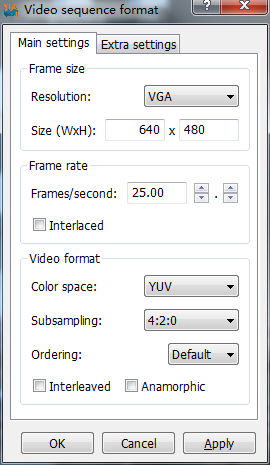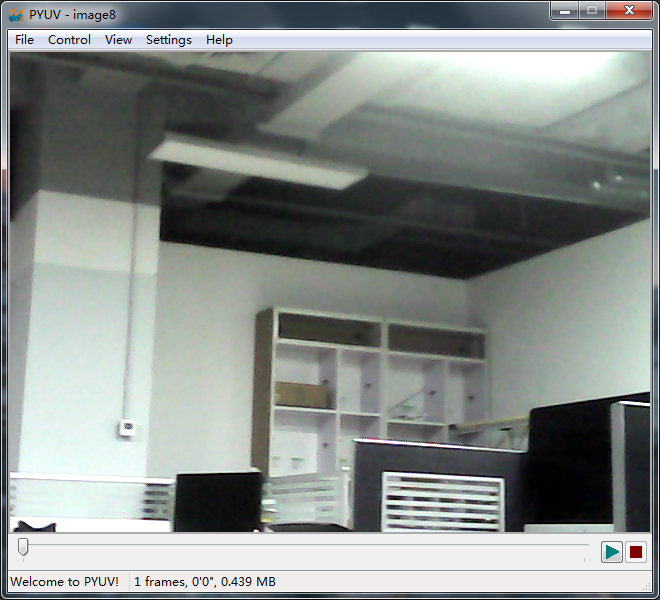本文主要是介绍V4L2视频采集与H264编码2—v4l2采集YUV数据,希望对大家解决编程问题提供一定的参考价值,需要的开发者们随着小编来一起学习吧!
在上一篇中因为是在PC机上使用的USB摄像头只能支持GPEG image格式,但是H264编码需要使用YUV数据,所以我找了个ARM开发板来做测试。本以为代码从PC机移植到开发板是很简单的一个事,谁知因为平台或是V4L2底层驱动的不同,最终也是花了九牛二虎之力才把问题给解了。话不多说,直接上代码:
- /*=============================================================================
- # FileName: v4l2.c
- # Desc: this program aim to get image from USB camera,
- # used the V4L2 interface.
- # Author: Licaibiao
- # Version:
- # LastChange: 2016-12-10
- # History:
- =============================================================================*/
- #include <unistd.h>
- #include <sys/types.h>
- #include <sys/stat.h>
- #include <fcntl.h>
- #include <stdio.h>
- #include <sys/ioctl.h>
- #include <stdlib.h>
- #include <linux/types.h>
- #include <linux/videodev2.h>
- #include <malloc.h>
- #include <math.h>
- #include <string.h>
- #include <sys/mman.h>
- #include <errno.h>
- #include <assert.h>
- #define FILE_VIDEO "/dev/video0"
- #define JPG "./out/image%d"
- typedef struct{
- voidvoid *start;
- int length;
- }BUFTYPE;
- BUFTYPE *usr_buf;
- static unsigned int n_buffer = 0;
- /*set video capture ways(mmap)*/
- int init_mmap(int fd)
- {
- /*to request frame cache, contain requested counts*/
- struct v4l2_requestbuffers reqbufs;
- memset(&reqbufs, 0, sizeof(reqbufs));
- reqbufs.count = 1; /*the number of buffer*/
- reqbufs.type = V4L2_BUF_TYPE_VIDEO_CAPTURE;
- reqbufs.memory = V4L2_MEMORY_MMAP;
- if(-1 == ioctl(fd,VIDIOC_REQBUFS,&reqbufs))
- {
- perror("Fail to ioctl 'VIDIOC_REQBUFS'");
- exit(EXIT_FAILURE);
- }
- n_buffer = reqbufs.count;
- printf("n_buffer = %d\n", n_buffer);
- //usr_buf = calloc(reqbufs.count, sizeof(usr_buf));
- usr_buf = calloc(reqbufs.count, sizeof(BUFTYPE));
- if(usr_buf == NULL)
- {
- printf("Out of memory\n");
- exit(-1);
- }
- /*map kernel cache to user process*/
- for(n_buffer = 0; n_buffer < reqbufs.count; ++n_buffer)
- {
- //stand for a frame
- struct v4l2_buffer buf;
- memset(&buf, 0, sizeof(buf));
- buf.type = V4L2_BUF_TYPE_VIDEO_CAPTURE;
- buf.memory = V4L2_MEMORY_MMAP;
- buf.index = n_buffer;
- /*check the information of the kernel cache requested*/
- if(-1 == ioctl(fd,VIDIOC_QUERYBUF,&buf))
- {
- perror("Fail to ioctl : VIDIOC_QUERYBUF");
- exit(EXIT_FAILURE);
- }
- usr_buf[n_buffer].length = buf.length;
- usr_buf[n_buffer].start = (charchar *)mmap(NULL,buf.length,PROT_READ | PROT_WRITE,MAP_SHARED, fd,buf.m.offset);
- if(MAP_FAILED == usr_buf[n_buffer].start)
- {
- perror("Fail to mmap");
- exit(EXIT_FAILURE);
- }
- }
- }
- int open_camera(void)
- {
- int fd;
- struct v4l2_input inp;
- fd = open(FILE_VIDEO, O_RDWR | O_NONBLOCK,0);
- if(fd < 0)
- {
- fprintf(stderr, "%s open err \n", FILE_VIDEO);
- exit(EXIT_FAILURE);
- };
- inp.index = 0;
- if (-1 == ioctl (fd, VIDIOC_S_INPUT, &inp))
- {
- fprintf(stderr, "VIDIOC_S_INPUT \n");
- }
- return fd;
- }
- int init_camera(int fd)
- {
- struct v4l2_capability cap; /* decive fuction, such as video input */
- struct v4l2_format tv_fmt; /* frame format */
- struct v4l2_fmtdesc fmtdesc; /* detail control value */
- struct v4l2_control ctrl;
- int ret;
- /*show all the support format*/
- memset(&fmtdesc, 0, sizeof(fmtdesc));
- fmtdesc.index = 0 ; /* the number to check */
- fmtdesc.type=V4L2_BUF_TYPE_VIDEO_CAPTURE;
- /* check video decive driver capability */
- if(ret=ioctl(fd, VIDIOC_QUERYCAP, &cap)<0)
- {
- fprintf(stderr, "fail to ioctl VIDEO_QUERYCAP \n");
- exit(EXIT_FAILURE);
- }
- /*judge wherher or not to be a video-get device*/
- if(!(cap.capabilities & V4L2_BUF_TYPE_VIDEO_CAPTURE))
- {
- fprintf(stderr, "The Current device is not a video capture device \n");
- exit(EXIT_FAILURE);
- }
- /*judge whether or not to supply the form of video stream*/
- if(!(cap.capabilities & V4L2_CAP_STREAMING))
- {
- printf("The Current device does not support streaming i/o\n");
- exit(EXIT_FAILURE);
- }
- printf("\ncamera driver name is : %s\n",cap.driver);
- printf("camera device name is : %s\n",cap.card);
- printf("camera bus information: %s\n",cap.bus_info);
- /*display the format device support*/
- printf("\n");
- while(ioctl(fd,VIDIOC_ENUM_FMT,&fmtdesc)!=-1)
- {
- printf("support device %d.%s\n",fmtdesc.index+1,fmtdesc.description);
- fmtdesc.index++;
- }
- printf("\n");
- /*set the form of camera capture data*/
- tv_fmt.type = V4L2_BUF_TYPE_VIDEO_CAPTURE; /*v4l2_buf_typea,camera must use V4L2_BUF_TYPE_VIDEO_CAPTURE*/
- tv_fmt.fmt.pix.width = 680;
- tv_fmt.fmt.pix.height = 480;
- tv_fmt.fmt.pix.pixelformat = V4L2_PIX_FMT_YUV420; /*V4L2_PIX_FMT_YYUV*/
- tv_fmt.fmt.pix.field = V4L2_FIELD_NONE; /*V4L2_FIELD_NONE*/
- if (ioctl(fd, VIDIOC_S_FMT, &tv_fmt)< 0)
- {
- fprintf(stderr,"VIDIOC_S_FMT set err\n");
- exit(-1);
- close(fd);
- }
- init_mmap(fd);
- }
- int start_capture(int fd)
- {
- unsigned int i;
- enum v4l2_buf_type type;
- /*place the kernel cache to a queue*/
- for(i = 0; i < n_buffer; i++)
- {
- struct v4l2_buffer buf;
- memset(&buf, 0, sizeof(buf));
- buf.type = V4L2_BUF_TYPE_VIDEO_CAPTURE;
- buf.memory = V4L2_MEMORY_MMAP;
- buf.index = i;
- if(-1 == ioctl(fd, VIDIOC_QBUF, &buf))
- {
- perror("Fail to ioctl 'VIDIOC_QBUF'");
- exit(EXIT_FAILURE);
- }
- }
- type = V4L2_BUF_TYPE_VIDEO_CAPTURE;
- if(-1 == ioctl(fd, VIDIOC_STREAMON, &type))
- {
- printf("i=%d.\n", i);
- perror("VIDIOC_STREAMON");
- close(fd);
- exit(EXIT_FAILURE);
- }
- return 0;
- }
- int process_image(voidvoid *addr, int length)
- {
- FILEFILE *fp;
- static int num = 0;
- char image_name[20];
- sprintf(image_name, JPG, num++);
- if((fp = fopen(image_name, "w")) == NULL)
- {
- perror("Fail to fopen");
- exit(EXIT_FAILURE);
- }
- fwrite(addr, length, 1, fp);
- usleep(500);
- fclose(fp);
- return 0;
- }
- int read_frame(int fd)
- {
- struct v4l2_buffer buf;
- unsigned int i;
- memset(&buf, 0, sizeof(buf));
- buf.type = V4L2_BUF_TYPE_VIDEO_CAPTURE;
- buf.memory = V4L2_MEMORY_MMAP;
- //put cache from queue
- if(-1 == ioctl(fd, VIDIOC_DQBUF,&buf))
- {
- perror("Fail to ioctl 'VIDIOC_DQBUF'");
- exit(EXIT_FAILURE);
- }
- assert(buf.index < n_buffer);
- //read process space's data to a file
- process_image(usr_buf[buf.index].start, usr_buf[buf.index].length);
- if(-1 == ioctl(fd, VIDIOC_QBUF,&buf))
- {
- perror("Fail to ioctl 'VIDIOC_QBUF'");
- exit(EXIT_FAILURE);
- }
- return 1;
- }
- int mainloop(int fd)
- {
- int count = 10;
- while(count-- > 0)
- {
- for(;;)
- {
- fd_set fds;
- struct timeval tv;
- int r;
- FD_ZERO(&fds);
- FD_SET(fd,&fds);
- /*Timeout*/
- tv.tv_sec = 2;
- tv.tv_usec = 0;
- r = select(fd + 1,&fds,NULL,NULL,&tv);
- if(-1 == r)
- {
- if(EINTR == errno)
- continue;
- perror("Fail to select");
- exit(EXIT_FAILURE);
- }
- if(0 == r)
- {
- fprintf(stderr,"select Timeout\n");
- exit(-1);
- }
- if(read_frame(fd))
- break;
- }
- }
- return 0;
- }
- void stop_capture(int fd)
- {
- enum v4l2_buf_type type;
- type = V4L2_BUF_TYPE_VIDEO_CAPTURE;
- if(-1 == ioctl(fd,VIDIOC_STREAMOFF,&type))
- {
- perror("Fail to ioctl 'VIDIOC_STREAMOFF'");
- exit(EXIT_FAILURE);
- }
- }
- void close_camera_device(int fd)
- {
- unsigned int i;
- for(i = 0;i < n_buffer; i++)
- {
- if(-1 == munmap(usr_buf[i].start,usr_buf[i].length))
- {
- exit(-1);
- }
- }
- free(usr_buf);
- if(-1 == close(fd))
- {
- perror("Fail to close fd");
- exit(EXIT_FAILURE);
- }
- }
- void main(void)
- {
- int fd;
- fd = open_camera();
- init_camera(fd);
- start_capture(fd);
- mainloop(fd);
- stop_capture(fd);
- close_camera_device(fd);
- }
(1)camera 打开由阻塞打开改为了非阻塞方式打开
(2)mmap 由原来的MAP_PRIVATE 模式改为MAP_SHARED方式
(3)imag 格式由原来的V4L2_PIX_FMT_JPEG 改为V4L2_PIX_FMT_YUV420
(4)在我的开发板中,必须设定camera 设备的索引号,也就是上面代码中的ioctl (fd, VIDIOC_S_INPUT, &inp) ,值为inp.index = 0; 如果不设置,select的时候会出现select timeout 的问题。
将上面代码交叉编译后放到开发板上去运行,结果如下:
- /tmp # ./test
- camera driver name is : sunxi-vfe
- camera device name is : sunxi-vfe
- camera bus information: sunxi_vfe vfe.2
- support device 1.planar YUV 422
- support device 2.planar YUV 420
- support device 3.planar YVU 420
- support device 4.planar YUV 422 UV combined
- support device 5.planar YUV 420 UV combined
- support device 6.planar YUV 422 VU combined
- support device 7.planar YUV 420 VU combined
- support device 8.MB YUV420
- support device 9.YUV422 YUYV
- support device 10.YUV422 YVYU
- support device 11.YUV422 UYVY
- support device 12.YUV422 VYUY
- support device 13.RAW Bayer BGGR 8bit
- support device 14.RAW Bayer GBRG 8bit
- support device 15.RAW Bayer GRBG 8bit
- support device 16.RAW Bayer RGGB 8bit
- support device 17.RAW Bayer BGGR 10bit
- support device 18.RAW Bayer GBRG 10bit
- support device 19.RAW Bayer GRBG 10bit
- support device 20.RAW Bayer RGGB 10bit
- support device 21.RAW Bayer BGGR 12bit
- support device 22.RAW Bayer GBRG 12bit
- support device 23.RAW Bayer GRBG 12bit
- support device 24.RAW Bayer RGGB 12bit
- n_buffer = 3
- /tmp # ls
- hostapd messages out test utmp
- /tmp # cd out
- /tmp/out # ls
- image0 image2 image4 image6 image8
- image1 image3 image5 image7 image9
- /tmp/out # ls -l
- total 4520
- -rw-r--r-- 1 root root 460800 Jan 1 00:01 image0
- -rw-r--r-- 1 root root 460800 Jan 1 00:01 image1
- -rw-r--r-- 1 root root 460800 Jan 1 00:01 image2
- -rw-r--r-- 1 root root 460800 Jan 1 00:01 image3
- -rw-r--r-- 1 root root 460800 Jan 1 00:01 image4
- -rw-r--r-- 1 root root 460800 Jan 1 00:01 image5
- -rw-r--r-- 1 root root 460800 Jan 1 00:01 image6
- -rw-r--r-- 1 root root 460800 Jan 1 00:01 image7
- -rw-r--r-- 1 root root 460800 Jan 1 00:01 image8
- -rw-r--r-- 1 root root 460800 Jan 1 00:01 image9
- /tmp/out #
可以将image文件拷出来,使用pYUV 软件查看YUV图片。这里需要注意,使用pYUV 查看YUV图片的时候,需要正确设置图片格式,按我上面代码采集的数据格式,其设置如下图:
正常打开显示的图片为:
到这里采集YUV数据就结束了,下一章介绍使用X264库将YUV数据编码成H264视频文件。
这篇关于V4L2视频采集与H264编码2—v4l2采集YUV数据的文章就介绍到这儿,希望我们推荐的文章对编程师们有所帮助!






